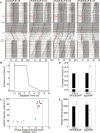Targeted destruction of photosensitive retinal ganglion cells with a saporin conjugate alters the effects of light on mouse circadian rhythms
- PMID: 18773079
- PMCID: PMC2519834
- DOI: 10.1371/journal.pone.0003153
Targeted destruction of photosensitive retinal ganglion cells with a saporin conjugate alters the effects of light on mouse circadian rhythms
Abstract
Non-image related responses to light, such as the synchronization of circadian rhythms to the day/night cycle, are mediated by classical rod/cone photoreceptors and by a small subset of retinal ganglion cells that are intrinsically photosensitive, expressing the photopigment, melanopsin. This raises the possibility that the melanopsin cells may be serving as a conduit for photic information detected by the rods and/or cones. To test this idea, we developed a specific immunotoxin consisting of an anti-melanopsin antibody conjugated to the ribosome-inactivating protein, saporin. Intravitreal injection of this immunotoxin results in targeted destruction of melanopsin cells. We find that the specific loss of these cells in the adult mouse retina alters the effects of light on circadian rhythms. In particular, the photosensitivity of the circadian system is significantly attenuated. A subset of animals becomes non-responsive to the light/dark cycle, a characteristic previously observed in mice lacking rods, cones, and functional melanopsin cells. Mice lacking melanopsin cells are also unable to show light induced negative masking, a phenomenon known to be mediated by such cells, but both visual cliff and light/dark preference responses are normal. These data suggest that cells containing melanopsin do indeed function as a conduit for rod and/or cone information for certain non-image forming visual responses. Furthermore, we have developed a technique to specifically ablate melanopsin cells in the fully developed adult retina. This approach can be applied to any species subject to the existence of appropriate anti-melanopsin antibodies.
Conflict of interest statement
Figures








Similar articles
-
Immunotoxin-induced ablation of melanopsin retinal ganglion cells in a non-murine mammalian model.J Comp Neurol. 2009 Sep 10;516(2):125-40. doi: 10.1002/cne.22103. J Comp Neurol. 2009. PMID: 19575450
-
Melanopsin--shedding light on the elusive circadian photopigment.Chronobiol Int. 2004 Mar;21(2):189-204. doi: 10.1081/cbi-120037816. Chronobiol Int. 2004. PMID: 15332341 Free PMC article. Review.
-
Photic Regulation of Circadian Rhythms and Voluntary Ethanol Intake: Role of Melanopsin-expressing Intrinsically Photosensitive Retinal Ganglion Cells.J Biol Rhythms. 2021 Apr;36(2):146-159. doi: 10.1177/0748730420981228. Epub 2020 Dec 28. J Biol Rhythms. 2021. PMID: 33357136
-
C-terminal phosphorylation regulates the kinetics of a subset of melanopsin-mediated behaviors in mice.Proc Natl Acad Sci U S A. 2017 Mar 7;114(10):2741-2746. doi: 10.1073/pnas.1611893114. Epub 2017 Feb 21. Proc Natl Acad Sci U S A. 2017. PMID: 28223508 Free PMC article.
-
Melanopsin and inner retinal photoreception.Cell Mol Life Sci. 2010 Jan;67(1):99-111. doi: 10.1007/s00018-009-0155-7. Epub 2009 Oct 29. Cell Mol Life Sci. 2010. PMID: 19865798 Free PMC article. Review.
Cited by
-
Co-expression of two subtypes of melatonin receptor on rat M1-type intrinsically photosensitive retinal ganglion cells.PLoS One. 2015 Feb 25;10(2):e0117967. doi: 10.1371/journal.pone.0117967. eCollection 2015. PLoS One. 2015. PMID: 25714375 Free PMC article.
-
Melanopsin-dependent light avoidance in neonatal mice.Proc Natl Acad Sci U S A. 2010 Oct 5;107(40):17374-8. doi: 10.1073/pnas.1008533107. Epub 2010 Sep 20. Proc Natl Acad Sci U S A. 2010. PMID: 20855606 Free PMC article.
-
Burning the candle at both ends: Intraretinal signaling of intrinsically photosensitive retinal ganglion cells.Front Cell Neurosci. 2023 Jan 6;16:1095787. doi: 10.3389/fncel.2022.1095787. eCollection 2022. Front Cell Neurosci. 2023. PMID: 36687522 Free PMC article. Review.
-
Melanopsin and mechanisms of non-visual ocular photoreception.J Biol Chem. 2012 Jan 13;287(3):1649-56. doi: 10.1074/jbc.R111.301226. Epub 2011 Nov 10. J Biol Chem. 2012. PMID: 22074930 Free PMC article. Review.
-
Oxygen-induced retinopathy induces short-term glial stress and long-term impairment of photoentrainment in mice.Graefes Arch Clin Exp Ophthalmol. 2014 Apr;252(4):595-608. doi: 10.1007/s00417-014-2579-5. Epub 2014 Feb 9. Graefes Arch Clin Exp Ophthalmol. 2014. PMID: 24509649
References
-
- Berson DM, Dunn FA, Takao M. Phototransduction by retinal ganglion cells that set the circadian clock. Science. 2002;295:1070–1073. - PubMed
-
- Gooley JJ, Lu J, Chou TC, Scammell TE, Saper CB. Melanopsin in cells of origin of the retinohypothalamic tract. Nat Neurosci. 2001;4:1165. - PubMed
-
- Yoshimura T, Nishio M, Goto M, Ebihara S. Differences in circadian photosensitivity between retinally degenerate CBA/J mice ( rd/rd ) and normal CBA/N mice (+/+). Journal of Biological Rhythms. 1994;9:51–60. - PubMed
-
- Foster RG, Provencio I, Hudson D, Fiske S, De Grip W, et al. Circadian photoreception in the retinally degenerate mouse (rd/rd). J Comp Physiol [A] 1991;169:39–50. - PubMed
Publication types
MeSH terms
Substances
Grants and funding
LinkOut - more resources
Full Text Sources
Other Literature Sources

